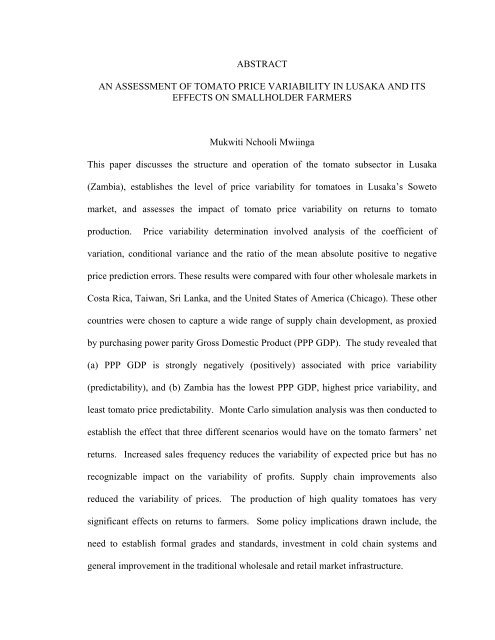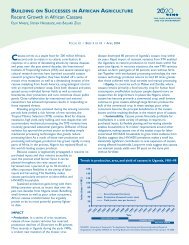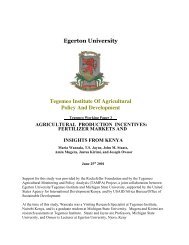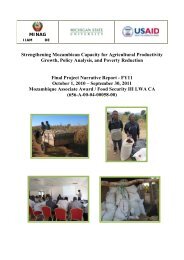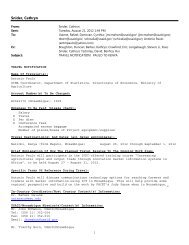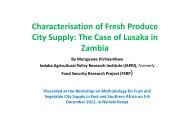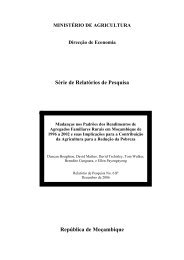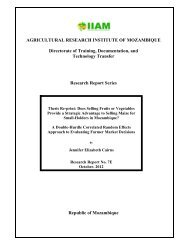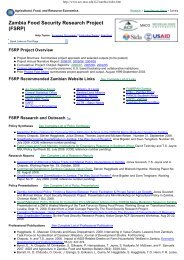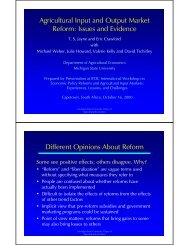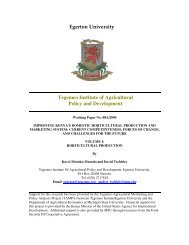- Page 1: AN ASSESSMENT OF TOMATO PRICE VARIA
- Page 5 and 6: to the Dean, School of Agricultural
- Page 7 and 8: 3.4.1 Variability and Predictabilit
- Page 9 and 10: LIST OF TABLES Table 2.1: Budget Sh
- Page 11 and 12: LIST OF FIGURES Figure 1.1: Geograp
- Page 13 and 14: 1.1 Background CHAPTER 1 INTRODUCTI
- Page 15 and 16: (Ksh 1 )7.5 billion) of total veget
- Page 17 and 18: chains and independent supermarkets
- Page 19 and 20: towards lowering the costs, encoura
- Page 21 and 22: Chapter 5 concludes the thesis with
- Page 23 and 24: andomized cluster sample design. Th
- Page 25 and 26: 2.2 Methods With these three sets o
- Page 27 and 28: perceptions of farmers and traders
- Page 29 and 30: Table 2.2: Budget Share of Differen
- Page 31 and 32: Table 2.3: Budget Share of Differen
- Page 33 and 34: Figure 2.1: Channel Map for Tomato
- Page 35 and 36: Table 2.4: Key Characteristics of T
- Page 37 and 38: Table 2.6 cont’d Area Province Ma
- Page 39 and 40: Figure 2.2: Monthly Soweto Wholesal
- Page 41 and 42: from all 150 supply areas while cha
- Page 43 and 44: Table 2.7: Retail Outlet Market Sha
- Page 45 and 46: Table 2.9: Retail Outlet Market Sha
- Page 47 and 48: Freshmark mostly prefers to have la
- Page 49 and 50: With the dual procurement system th
- Page 51 and 52: Compared to Soweto market which had
- Page 53 and 54:
During this period, tomato prices w
- Page 55 and 56:
Figure 2.4: Tomato Pricing at Whole
- Page 57 and 58:
Table 2.11: Mean Tomato Prices for
- Page 59 and 60:
2.5 Summary and Conclusions 2.5.1 I
- Page 61 and 62:
In the period January 2007 to June
- Page 63 and 64:
CHAPTER 3 TOMATO PRICE VARIABILITY
- Page 65 and 66:
In the hot wet season, disease prev
- Page 67 and 68:
patterns differ across markets, red
- Page 69 and 70:
case of a flood, its effects could
- Page 71 and 72:
3.2 Hypothesis Testing The level of
- Page 73 and 74:
Table 3.2: Description of Data Used
- Page 75 and 76:
Coefficient of Variation= Where;
- Page 77 and 78:
Where; P t - the observed tomato pr
- Page 79 and 80:
A look at price variability in each
- Page 81 and 82:
For further comparison of the mean
- Page 83 and 84:
Figure 3.2: Comparison of the Ratio
- Page 85 and 86:
Figure 3.4: Comparison of Condition
- Page 87 and 88:
thereby making the farmers more con
- Page 89 and 90:
d. The absence of cold chain system
- Page 91 and 92:
depend on local suppliers for their
- Page 93 and 94:
The provision of market information
- Page 95 and 96:
upon arrival in the market. Lower q
- Page 97 and 98:
- Assets used in tomato production,
- Page 99 and 100:
Tomato price data used for analysis
- Page 101 and 102:
4.4 The Monte Carlo Model The Basel
- Page 103 and 104:
CF Fixed conversion factor of 37.
- Page 105 and 106:
- Seedling costs - Seed costs - Fie
- Page 107 and 108:
differences were due to differences
- Page 109 and 110:
Table 4.2: Farmer Characteristics B
- Page 111 and 112:
Group 1 Table 4.4: Basic Informatio
- Page 113 and 114:
farmers can in practice suffer a to
- Page 115 and 116:
4.5.2 Simulation Results for the Di
- Page 117 and 118:
Scenario 1: Increased Sales Frequen
- Page 119 and 120:
knowledge of what their yields and
- Page 121 and 122:
Table 4.12: The Effect of Supply Ch
- Page 123 and 124:
Table 4.13: Production of Low and H
- Page 125 and 126:
quality; when supplies are high in
- Page 127 and 128:
etter farmers would attempt to have
- Page 129 and 130:
CHAPTER 5 CONCLUSION This study was
- Page 131 and 132:
top twelve tomato supply areas acco
- Page 133 and 134:
Freshpikt and Rivonia are the main
- Page 135 and 136:
on prediction errors from a price p
- Page 137 and 138:
absence of a cold chain system, the
- Page 139 and 140:
price variability, the expectation
- Page 141 and 142:
In the scenario analysis of increas
- Page 143 and 144:
price variability affects the diffe
- Page 145 and 146:
facilitate the provision of low cos
- Page 147 and 148:
APPENDICES 135
- Page 149 and 150:
i. What type of farmers do they pre
- Page 151 and 152:
Taipei, Taiwan Table A2.3. Model Su
- Page 153 and 154:
Colombo, Sri Lanka A2.7. Model Summ
- Page 155 and 156:
APPENDIX 3. Graphs of Price Predict
- Page 157 and 158:
Figure A3.3. Price Prediction Resid
- Page 159 and 160:
Figure A3.5. Price Prediction Resid
- Page 161 and 162:
9. Name of Main Respondent (if diff
- Page 163 and 164:
SECTION 3 - HARVEST AND SALES OF CR
- Page 165 and 166:
SECTION 4 - PLANTING AND HARVEST PA
- Page 167 and 168:
155 _______________ _______________
- Page 169 and 170:
5.2 Planted Seedlings Phase Field #
- Page 171 and 172:
PHASE 2 - FIELD PREPARATION 5.5 Enu
- Page 173 and 174:
5.7 Irrigation prior to transplanti
- Page 175 and 176:
4=Spraying 5=Weeding 6=Placement of
- Page 177 and 178:
Field # Please list all the types o
- Page 179 and 180:
that you used in your tomato produc
- Page 181 and 182:
Trailer Van/light truck Borehole Bo
- Page 183 and 184:
Field # Time from 1 st harvest Phas
- Page 185 and 186:
Second Field Field # Time from 1 st
- Page 187 and 188:
Field # Time from 1 st harvest Phas
- Page 189 and 190:
Second field: 8.0 Harvesting and Ma
- Page 191 and 192:
APPENDIX 5. Distribution of Sampled
- Page 193 and 194:
Figure A6.2. Distributions for Cost
- Page 195 and 196:
Figure A6.4. Distributions for Cost
- Page 197 and 198:
APPENDIX 7. Histograms of Farmer Pr
- Page 199 and 200:
Figure A7.3. Baseline Scenario: His
- Page 201 and 202:
Figure A7.5. Increased Sales Freque
- Page 203 and 204:
Figure A7.7. Increased Sales Freque
- Page 205 and 206:
Figure A7.9. Supply Chain Improveme
- Page 207 and 208:
Figure A7.11. Supply Chain Improvem
- Page 209 and 210:
Figure A7.13. Scenario on Quality o
- Page 211 and 212:
Figure A7.15. Scenario on Quality o
- Page 213 and 214:
Figure A7.17. Scenario on Low Quali
- Page 215 and 216:
Figure A7.19. Scenario on Low Quali
- Page 217 and 218:
BIBLIOGRAPHY 205
- Page 219:
Stevens, C. and J. Kennan (1999). W


